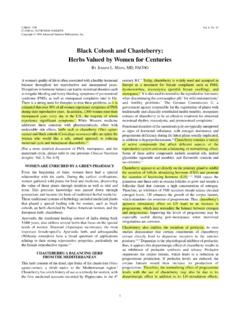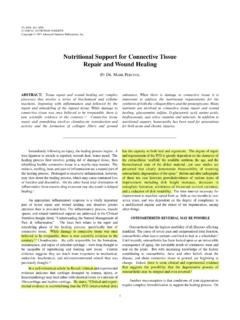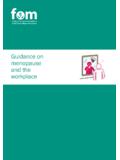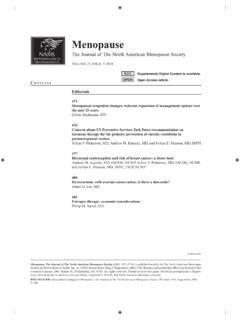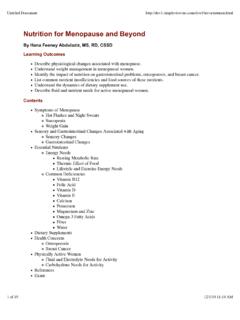Transcription of A Natural Approach to Menopause - acudoc.com
1 SIGNS AND SYMPTOMS OF MENOPAUSEAs a woman s childbearing years come to an end, she beginsto experience the first signs of Menopause . Perimenopause, thetime leading up to Menopause , usually begins around age this time, the body is adjusting to erratic hormone levelswhich become evident by the start of irregular menstrual periods(shortened or lengthened cycles and diminished menstrual flow)and hot flashes/flushes. Although the ovaries continue to secreteestrogen and progesterone throughout this period, hormonal levelsbegin to decline, and the availability of sex hormones becomesincreasingly dependent upon the adrenal glands and adipose brought about by surgery, chemotherapy, or other factors, Natural , or physiologic, Menopause occurs in most women by age50-51.
2 Menopause is defined as the loss of ovarian function,characterized by the actual cessation of menses. Prompted by thedecline in estrogen and progesterone production, and rising follicle-stimulating hormone (FSH) and luteinizing hormone(LH) levels, menopausal symptoms may include hot flashes ornight sweats (in 80% of women); decreased vaginal lubrication;and thinned vaginal mucosa. Other symptoms may include moodswings, insomnia, depression, urinary problems and incontinence,vaginal irritation, and painful intercourse (Table 1). Menopausal women also experience a decline in testosterone,although this aspect of Menopause is often neglected. Ovariantestosterone production is said to be substantially decreased in50% of postmenopausal , diminishedadrenal androgen synthesis also occurs, but is more likely a functionof age rather than Menopause per se.
3 The decline in circulatingandrogens, specifically testosterone, has been termed adrenopause by some experts, and is largely responsible for diminished sexual function, including loss of libido and loss of sexualresponse in postmenopausal 1. Signs of Menopause Irregular or absent menstrual periods Hot flashes/flushes or night sweats Decreased vaginal lubrication and thinned vaginal mucosa which may cause painful intercourse Mood swings Insomnia Depression Forgetfulness and impaired concentration ability Urinary incontinence Loss of libido (due to declining testosterone)DECLINING ESTROGEN:WHAT THIS MEANS FOR DISEASE RISKD epending on the health of the woman, the decline in estrogenthat occurs during Menopause may not only cause the transientsymptoms described above, it may also contribute to disease,particularly in women who already have an increased riskbecause of heredity, illness, or because of poor dietary and two most prevalent diseases associated with postmenopausalwomen are osteoporosis and heart disease.
4 Both of these diseasesare strongly linked to estrogen level as well as dietary andlifestyle habits. Table 2 lists some of the risk factors associatedwith cardiovascular disease and osteoporosis. A Natural Approach to MenopauseBYJOSEPHL. MAYO, MD, FACOGABSTRACT:Today in the United States nearly 20 millionwomen are experiencing Menopause . This number will grow toapproximately 60 million by the year womenare faced with the challenge of managing a barrage of symptoms,both physiological and psychological, as well as the increasedrisk of age-related disease, particularly heart disease and osteoporosis. Many women today are seeking Natural support formenopause not only because of the risks associated with hormone replacement therapy but also because of the recognitionthat Menopause is not a disease, but rather a Natural transitionthat does not necessarily require drugs.
5 Natural treatment strategies should focus on both symptom relief and disease prevention, and may include nutritional supplements, herbs, andhealthy dietary and lifestyle choices. CNI507 8/99 APPLIED NUTRITIONAL SCIENCE REPORTSC opyright 1997 by Advanced Nutrition Publications, Inc. rev. 19991 Vol. 5, No. 7 Table 2. Risk Factors Associated with Cardiovascular Disease and OsteoporosisCardiovascular Disease Reduced estrogen as a result of Menopause Smoking High blood pressure Elevated levels of plasma/serum cholesterol High LDL levels Low HDL levels Elevated plasma triglycerides Diabetes Obesity Truncal obesity ( apple-shape ) Stress Lack of exerciseOsteoporosis Reduced estrogen as a result of Menopause Physical inactivity Smoking Alcohol consumption Thinness/low fat mass Heredity Asian or Caucasian descent Drugs such as corticosteroids and anticonvulsants Inadequate calcium and vitamin D intakeEstrogen plays an important role in bone health by decreasingthe rate of bone resorption.
6 As estrogen levels decline, the body sability to keep up with the Natural process of bone turnover alsodeclines; as bone mass decreases, the risk of fractures increases.(For a detailed discussion of osteoporosis and bone health, seeClinical Nutrition Insightsvol. 5, no. 4.)Estrogen appears to naturally protect women from heart disease,presumably by promoting a favorable plasma lipid profile andhealthy comparison of plasma lipid levelsbetween non-obese, pre- and postmenopausal women showed significant increases for postmenopausal women in total cholesterol,low-density lipoprotein (LDL) cholesterol, and triglycerides, anddecreases in high-density lipoprotein (HDL) cholesterol. Theseeffects were observed after standardization for age, body massindex, and other confounding variables, and were thus accredited changes in plasma lipids that occur withmenopause are likely the result of many factors; however, estrogen may play both a direct and indirect role.
7 Estrogen itselfappears to lower LDL levels by up-regulation of apo , the reduced estrogen levels in post-menopausal women cause a relatively higher concentration ofcirculating testosterone. Elevated testosterone levels are knownto increase LDL levels and lower HDL levels by increasinghepatic lipase cardioprotective effects of estrogen are clearly seen inwomen taking estrogen replacement therapy. Unopposed estrogenreplacement has been shown to favorably alter blood lipids, helping to lower LDL levels and increase HDL levels in post-menopausal women. In 15 out of 19 studies, estrogen use reducedthe frequency of myocardial infarction or ischemic heart diseaseby about Unopposed estrogen therapy, however, has beenlinked to endometrial hormone replacementthat provides both estrogen and progestin poses less of a risk; however, because progestin modifies many of estrogen s physio-logical effects, the cardioprotective effect of combined HRTmay be While estrogen replacement can offer protection against heartdisease and even osteoporosis, it may not be the appropriate firstline of defense.
8 Differentiating between those risk factors thatare non-modifiable, such as heredity, body type (truncal obesity,or apple-shape ), and diabetes, and those that are modifiable( , diet and lifestyle) is an important step in determining thebest preventative risk for cancers of the breastand endometrium should also be taken into account. Modifyingrisk factors with healthy lifestyle choices that include exercise,stress reduction and relaxation, and eating the right foods areknown to play a significant role in reducing the overall risk toheart disease. Dietary recommendations should focus on a low-fat/high-fiber diet that is rich in antioxidants. Additionally,dietary modulation of eicosanoid production, as with fish oils,may also be suggests that fish oils rich inomega-3 fatty acids may offer considerable cardioprotective benefits such as helping to maintain healthy blood pressureand decreased platelet ADRENAL GLANDS.
9 PRESERVING HORMONALACTIVITY AND THE BODY S ADAPTOGENIC RESPONSEOnce a women reaches Menopause , the adrenal glands andfat cells become the primary sources for estrogen adrenals produce androstenedione, an androgen which isconverted to estrogen via the aromatase enzyme in peripheral tissues such as the skin, adipose, and adiposetissue is a primary location for androgen conversion to estrogen,relatively lean women tend to experience Menopause earlier thanheavier women. The majority of a postmenopausal woman s circulatingtestosterone is also dependent upon adrenal androstenedionesynthesis. The synthesis of adrenal androgens begins with cholesterol where it is converted to pregnenelone. Pregneneloneis converted to either the stress hormone cortisol or to dehy-droepiandrosterone (DHEA), which is subsequently converted toandrostenedione.
10 Finally, androstenedione is converted to eitherestrogen or testosterone. (See Table 3 for a schematic diagram ofthis process.) Despite the increasing reliance on the adrenal glands for sexhormone production during the perimenopausal and post-menopausal years, adrenal androgen synthesis actually decreasesby more than half by the time a woman reaches in circulating androgens occurs in both men and womenand is therefore associated with age rather than research surrounding supplemental DHEA has focusedon this age-related decline in androgen circulation and its impacton general health. DHEA levels are at their highest during a person stwenties and then decrease dramatically over the next five to decline has been associated with the diminishedsexual function, fatigue, and other age-related malfunctions thattend to occur with age.
